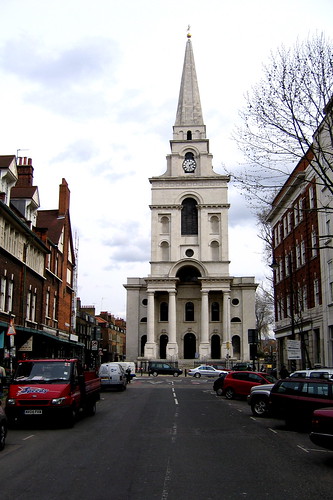Monday, September 19, 2005
christchurch, spitalfields
In 1902 Jack London arrived in London, and attempted to visit the East End. His friends told him not to, Thomas Cook’s the travel agency, who could organize a trek across Tibet--could take you to the very ends of the earth, said it was impossible, and a cab driver didn’t know how to find it (London cab drivers still don’t want to go anywhere they don’t think they’ll pick up a good fare, although I've never heard of them saying they couldn't find the "East End." Besides, there are plenty of fares there now). So, nearly 30 years before George Orwell was down and out in Paris and London, Jack London donned a scruffy suit of second hand clothes, and walked east to see how the other half lived. Here he describes the garden of Hawksmoor’s Christchurch.
The shadow of Christ's Church falls across Spitalfields Garden, and in the shadow of Christ's Church, at three o'clock in the afternoon, I saw a sight I never wish to see again. There are no flowers in this garden, which is smaller than my own rose garden at home. Grass only grows here, and it is surrounded by sharp-spiked iron fencing, as are all the parks of London Town, so that homeless men and women may not come in at night and sleep upon it..
As we entered the garden, an old woman, between fifty and sixty, passed us, striding with sturdy intention if somewhat rickety action, with two bulky bundles, covered with sacking, slung fore and aft upon her. She was a woman tramp, a houseless soul, too independent to drag her failing carcass through the workhouse door. Like the snail, she carried her home with her. In the two sacking-covered bundles were her household goods, her wardrobe, linen, and dear feminine possessions.
We went up the narrow gravelled walk. On the benches on either side was arrayed a mass of miserable and distorted humanity, the sight of which would have impelled Dore to more diabolical flights of fancy than he ever succeeded in achieving. It was a welter of rags and filth, of all manner of loathsome skin diseases, open sores, bruises, grossness, indecency, leering monstrosities, and bestial faces. A chill, raw wind was blowing, and these creatures huddled there in their rags, sleeping for the most part, or trying to sleep. Here were a dozen women, ranging in age from twenty years to seventy. Next a babe, possibly of nine months, lying asleep, flat on the hard bench, with neither pillow nor covering, nor with any one looking after it. Next, half a dozen men, sleeping bolt upright or leaning against one another in their sleep. In one place a family group, a child asleep in its sleeping mother's arms, and the husband (or male mate) clumsily mending a dilapidated shoe. On another bench a woman trimming the frayed strips of her rags with a knife, and another woman, with thread and needle, sewing up rents. Adjoining, a man holding a sleeping woman in his arms. Farther on, a man, his clothing caked with gutter mud, asleep with head in the lap of a woman, not more than twenty-five years old, and also asleep. -- The People of the Abyss by Jack London (Lawrence Hill Books, New York, 1995)
For much of the twentieth century the small park remained a place where the homeless slept and was known, after the vermin that afflicted them, as Itchy Park (one of several green spaces in London to have that nickname).

Photo by Jack London. An illustrated The People of the Abyss is available online from berkeley.edu







